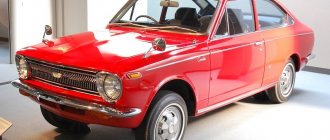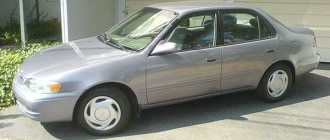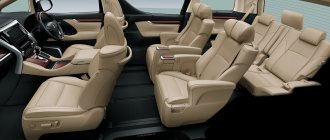Dashboard indicators
In any car, the instrument cluster indicators are located on the dashboard display.
1. Parking brake system status indicator and low brake fluid level,
a) The indicator lights up if: – the parking brake is applied;
Table. Instrument cluster indicators and sound signals.
| Parking brake system and low brake fluid level indicator | Rear fog light indicator |
| Anti-lock brake system (ABS) indicator | Power steering system fault indicator |
| Battery charging indicator | Automatic transmission selector position indicators |
| Low engine oil pressure indicator | Overdrive switch off indicator |
| Check engine light (CHECK ENGINE) | Traction Control Disable (TRC) Indicator |
| Low fuel indicator | VSC system indicator |
| Door open or loosely closed indicator | Slip indicator |
| Headlight high beam indicator | Tire pressure indicator |
| Turn Signal Indicators | Immobilizer system indicator |
| Airbag system (SRS) indicator | Automatic headlight leveling indicator |
| Driver seat belt indicator | Gear engaged indicator |
| Dimensions indicator | Manual shift mode indicator |
| Fog light indicator | Ignition key left in the lock or lights not turned off |
– low brake fluid level;
– the electrical circuit of the indicator is faulty.
b) If the indicator lights up while driving, you must slow down, pull off the road and carefully stop the car. You can slow down by stopping the engine and applying the parking brake, but be sure to press the brake pedal to turn on the brake lights to warn drivers behind you that you are braking.
Check the parking brake, it may be engaged. If the parking brake is turned off and the indicator remains on after it is turned off, there is a malfunction in the brake system. Check the brake fluid level in the reservoir.
– If the brake fluid level is low, add fluid and test the vehicle's braking performance in a safe place. If you feel that the brakes are still working reasonably well, then carefully drive the vehicle to the nearest repair facility. If the brakes do not work, the vehicle will need to be towed or towed for repairs.
Warning : Driving in a vehicle with low brake fluid is dangerous.
– If the brake fluid level is normal, then the indicator circuit may be faulty.
2.Anti-lock brake system (ABS) indicator. After turning on the ignition, the indicator lights up for a few seconds and then goes off. If the indicator lights up while driving, or the indicator does not light up or does not go out when the engine is turned on, there may be a malfunction in the anti-lock braking system.
Warning : Pressing the brake pedal multiple times may cause the indicator to turn on for a few seconds.
3. Battery charging indicator.
a) The indicator lights up when the ignition key is turned to the “ON” position and should go out after the engine starts.
b) If the indicator lights up while driving, then the charging system is faulty or the generator drive belt is loose (broken). However, the engine will continue to run until the battery is completely discharged. Turn off additional equipment (air conditioner, fan, radio, etc.) and move to the repair site.
4. Low engine oil pressure indicator.
a) The indicator lights up when the ignition key is turned to the “ON” position and should go out after the engine starts.
b) The indicator lights up if the engine oil pressure is too low.
c) If the indicator flashes or lights up while driving, you must pull over to the side of the road and turn off the engine.
– The indicator may flash after heavy braking or when the engine is idling. There is no malfunction if the indicator goes out with a slight increase in engine speed.
– The indicator may come on when the engine oil level is too low. But this indicator is not intended to inform you about low oil level, so check the level periodically with a dipstick.
Check the oil level and make sure there are no leaks.
– If the oil level is within acceptable limits and there are no leaks, tow or remove the vehicle for repair.
– If the oil level is below the minimum permissible level and there are no leaks, add oil and start the engine. If the light flashes or stays on, turn off the engine and have the vehicle towed or towed for repairs.
5. “Check engine” indicator (CHECK ENGINE).
The indicator lights up when the ignition key is turned to the “ON” position for a few seconds and then goes out, informing the driver that the engine management system is being checked. If the indicator stays on or comes on while driving, this indicates a problem with the electronic engine management system. In this case, it is necessary to move to the repair site and diagnose the engine control system.
6. Low fuel level indicator. The indicator lights up when the ignition key is in the “ON” position and the amount of fuel in the tank is less than 8 liters. Depending on the configuration of the car, the fuel may be enough for 40-60 km on a good road. On slopes or when turning corners, the indicator may come on due to fluctuations in the fuel in the tank.
Attention : do not drive with very low fuel level in the tank. Running out of all fuel can damage the catalytic converter.
7. Indicator of an open or loosely closed door.
The indicator remains on until all doors are firmly closed.
8. The headlight high beam indicator lights up when the high beam headlights are turned on.
9. Turn signal indicators. The indicators flash when the direction indicators or hazard lights are turned on.
alarms If the indicators blink too quickly, this indicates a poor connection in the turn signal circuit or a faulty turn signal lamp.
10. Airbag system (SRS) indicator.
The indicator lights up when the ignition key is in the “ON” position. After a few seconds the indicator will go out. If the indicator does not light up or lights up/flashes while driving, there is a malfunction in the SRS system components.
11. Driver's seat belt unfastened indicator. The indicator lights up when the ignition is turned on for a few seconds and then goes off if the driver is wearing a seat belt. If the driver is not wearing a seat belt, the indicator remains on.
12. The headlights indicator lights up when the headlights are turned on.
13. The fog light indicator lights up when the fog lights are turned on.
14. The rear fog lights turn on indicator lights up when the rear fog lights are turned on.
15. Power steering system malfunction indicator The indicator lights up when the ignition key is in the “ON” position. After a few seconds the indicator will go out. If the indicator does not light up or lights up/flashes while driving, there is a malfunction in the system.
16. Automatic transmission selector position indicators (“P”, “R”, “N”, “D”, “2” or “L”). When the automatic transmission selector is moved to any position, the corresponding indicator “P” lights up on the instrument cluster. “R”, “N”, “D”, “2” or “L”.
17. The overdrive switch-off indicator “O/D OFF” informs the driver that the use of an automatic transmission overdrive is prohibited. For a more detailed description, see the “Driving the car” section.
with automatic transmission.”
18. (Modification) Indicator for disabling the traction control system (TRC OFF).
The indicator lights up when the ignition key is in the “ON” position. After a few seconds the indicator goes out. When you press the “TRC OFF” switch, the system stops operating and the indicator lights up. If the indicator lights up while driving (the “TRC OFF” switch is not pressed) or the indicator does not light up or does not go out when the engine is turned on, then there may be a malfunction in the TRC, VSC, ABS, BA or EFI systems. For a more detailed description, see the section “Traction Control (TRC).
19. (Modification) Vehicle Stability Control (VSC) indicator.
The indicator lights up when the ignition key is in the “ON” position. After a few seconds the indicator goes out. The indicator lights up when there is a malfunction in the TRC, VSC, ABS, BA or EFI systems. For a more detailed description, see the “Vehicle Stability Control (VSC)” section.
20. (Modification) Slip indicator.
The indicator lights up when the ignition switch is in the “ON” position. After a few seconds the indicator goes out. The indicator flashes when the Traction Control System (TRC), Vehicle Stability Control (VSC) is operating, and when the wheels are slipping.
21. The tire pressure monitoring system indicator lights up for a few seconds when the ignition key is turned to the “ON” position, and then goes off. If the light stays on or comes on while driving, it indicates low pressure in one of the tires. You must stop immediately and adjust the tire pressure. For a more detailed description, see the “Tire Pressure Monitoring System” section.
22. Immobilizer system indicator. When you remove the key from the ignition switch, the immobilizer system indicator on the instrument cluster starts flashing.
For a more detailed description, see the “Door locking” section.
23. Automatic headlight leveling system indicator. The indicator lights up when the ignition key is turned to the “ON” position for a few seconds and then goes out. If the indicator lights up while driving, stop and turn off the ignition. Turn on the ignition again and if the indicator lights up and does not go out, this indicates a malfunction in the automatic headlight leveling system.
24. Gear engaged indicator. The indicator shows the engaged gear when the automatic transmission selector is moved to the “D”, “M”, “2”, “L” positions. When the automatic transmission selector is moved to the “P”, “R”, “N” positions, the indicator does not show anything. For a more detailed description, see the “Driving a car with automatic transmission” section.
25. The manual gear shift mode indicator lights up when the automatic transmission selector is moved to the “M” position. For a more detailed description, see the “Driving a car with automatic transmission” section.
26. Sound alarm on the car (buzzer).
a) The horn will sound if the driver's door is open with the ignition key in the “LOCK” or “ACC” position.
b) The sound signal is activated when the headlights are on and the key is removed from the ignition switch when the driver's door is opened. This signal informs the driver that the battery may be low.
Blocks under the hood
Location
General layout of blocks under the hood
Decoding
- ABS electronic control unit and pressure modulator (until 04.1999)
- ABS system relay unit (until 04.1999)
- mounting block No. 2 (J/B No. 2)
- relay and fuse box No. 5 (R/B No. 5)
- right front SRS sensor (from 04.1998)
- left front SRS sensor (from 04.1998)
Mounting block No. 2
Located on the left side of the engine compartment next to the pillar.
Photo - example and diagram from the block cover
Scheme
Purpose of fuses
| 1 | 5A ALT-S - Charging system |
| 2 | 10A HEAD (RH-UPR) - Right headlight (DRL - daytime running lights) |
| 3 | 15A EFI - 4A-FE, 5A-FE, 7A-FE, 4E-FE: Multiport fuel injection system/sequential multiport fuel injection system |
| 15A F-HTR - 2C-E: Multiport fuel injection system/sequential multiport fuel injection system | |
| 4 | 10A HORN - Horn, anti-theft system |
| 5 | 10A HAZARD - Hazard alarm, direction indicators |
| 6 | 15A AM2 – Starting system, fuses: “ST”, “IGN” |
| 7 | — |
| 8 | 10A HEAD (LH-UPR) - Left headlight (DRL - daytime running lights) |
| 9 | 15A DOME - Audio system, interior lighting, personal lighting, luggage compartment lighting, clock, daytime running lights, anti-theft system |
| 10 | — |
| 11 | — |
| 12 | — |
| 13 | — |
| 14 | 50A AM1 - Fuses: “CIG”, “TURN”, “GAUGE”, “ECU-IG”, “WIP” |
| 15 | 30A FAN - Cooling fan |
| 30A RDI - Cooling fan | |
| 16 | 40A MAIN - Starting system, fuses: "HEAD (LH) or HEAD (LH−UPR), "HEAD (RH) or HEAD (RH−UPR), "HEAD LH−Lo" and "HEAD RH−LO" |
| 17 | 100A ALT - Fuses: "RDI", "CDS", "AM1", "POWER", "D/L", "TAIL", OBD, "FOG", "ECU-B", "STOP", "DEF" "HTR" |
| 18 | 50A ABS - ABS |
Relay decoding
| R1 | Engine control unit (ENGINE MAIN) |
| R2 | 4A-FE, 5A-FE, 7A-FE, 4E-FE: Engine control unit (EFI) 2C-E: Fuel heater (F-HTR) |
| R3 | Headlights (HEAD) |
| R4 | Starter (ST) |
| R5 | Sound signal |
| R6 | Cooling fan (FAN NO.1) |
Relay and fuse block No. 5
Scheme
Description
| 1 | 30A CDS - Cooling fan |
| 2 | 10A HEAD (LH-LWR) - with DRL: Left headlight (DRL - daytime running lights) |
| 3 | 15A HEAD (RH-LWR) - with DRL: Right headlight |
| 4 | 7.5A DRL - Daytime running lights |
| R1 | Dimmer |
| R2 | Cooling fan (AC FAN NO.2) |
| R3 | Cooling fan (AC FAN NO.2) |
| R4 | Air Conditioning Compressor Clutch (AC MG) |
Problems with the shield
Common breakdowns of instrument clusters on Toyota Corolla include:
- Failure of devices due to breakdown of stepper motors or electronics. To restore functionality, you will need to replace damaged elements or install a new combination.
- Burnout of lighting system elements. The owner changes incandescent lamps himself; LEDs can be replaced at a service center.
- Turn off the backlight and some indicators. This indicates a failed fuse or broken wiring harness. On older cars (E100 or E110), the problem occurs when contact with the car body is broken.
Design features of different models of devices
The instrument panels of Corolla cars of different generations differ in the following elements:
- microprocessors that process information from controllers;
- switching connectors;
- digitization of instruments (for example, modifications for Japan have a speedometer with a maximum mark of 180 km/h);
- number and location of indicators;
- configuration and dimensions of the plastic casing;
- method of attachment to the frame.
The car owner may try to install a dashboard with additional features or a modified design. To ensure functionality, you will need to partially change the wiring harnesses or introduce additional wires.
Owners of cars manufactured in the 90s are forced to make repairs due to the natural wear and tear of components and the lack of spare parts to restore standard components.
When installing another dashboard on a Corolla E150 or E180, electronics reprogramming will be required, performed at a service center.
General recommendations
The instrument cluster of cars does not require periodic maintenance, but if the backlight LEDs fail, it is necessary to remove the assembly and re-solder the damaged elements.
Since the shield contains electronic components, interference with the structure leads to irreversible damage to the unit.
It is recommended to carry out repairs in a service center equipped with special equipment for soldering and testing the functionality of the unit.
What function does the element perform?
The instrument panel is designed to inform the driver about the operating modes and failures of various vehicle systems. There are special indicators indicating the inclusion of external lighting devices.
The display shows current and historical data stored in the memory of the on-board computer.
To read information in poor visibility conditions, LED backlighting with brightness adjustment (optional) is provided.










